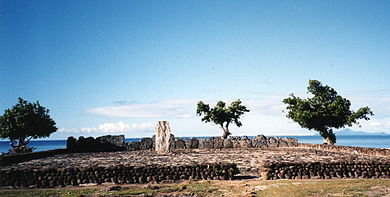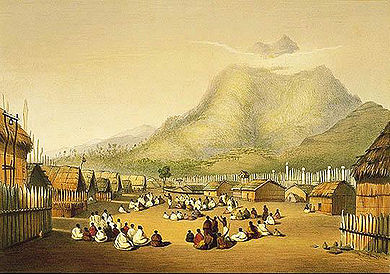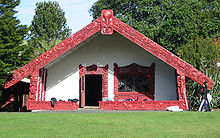- Marae
-
 Taputapuātea, an ancient marae constructed of stone on Ra'iātea in the Society Islands, restored in 1994.
Taputapuātea, an ancient marae constructed of stone on Ra'iātea in the Society Islands, restored in 1994.
A marae (in New Zealand Māori, Cook Islands Māori, Tahitian) malaʻe (in Tongan), malae (in Samoan and Hawaiian[citation needed]), is a communal or sacred place which serves religious and social purposes in Polynesian societies. In all these languages, the word also means "cleared, free of weeds, trees, etc." It generally consists of an area of cleared land roughly rectangular (the marae itself), bordered with stones or wooden posts (called au in Tahitian and Cook Islands Māori) perhaps with terraces (paepae) which were traditionally used for ceremonial purposes; and in some cases, a central stone ahu or a'u. In the Rapanui culture of Easter Island "ahu" has become a synonym for the whole marae complex).
In some modern Polynesian societies, notably that of the Māori of New Zealand, the marae is still a vital part of everyday life. However, in tropical Polynesia, most marae were destroyed or abandoned with the arrival of Christianity in the 19th Century and some of them have become an attraction for tourists or archaeologists. Nevertheless, the place where the marae were built are still considered as tapu in most islands. In the Cook Islands, a few marae (Arai-te-Tonga, Vaerota, Taputapuātea[1]) are still maintained, and are quickly tidied up before the investiture of a new ariki.
Contents
Etymology
The word has been reconstructed by linguists to Eastern Oceanic *malaqe with the meaning "open,cleared space used as meeting-place or ceremonial place".[2]
Marae in New Zealand
 A marae beneath Taupiri mountain, Waikato district, 19th century. This marae was associated with Pōtatau Te Wherowhero, a chief who became the first Māori king.
A marae beneath Taupiri mountain, Waikato district, 19th century. This marae was associated with Pōtatau Te Wherowhero, a chief who became the first Māori king.
In Māori society, the marae is a place where the culture can be celebrated, where the Māori language can be spoken, where intertribal obligations can be met, where customs can be explored and debated, where family occasions such as birthdays can be held, and where important ceremonies, such as welcoming visitors or farewelling the dead (tangihanga), can be performed. Like the related institutions of old Polynesia, the marae is a wāhi tapu, a 'sacred place' which carries great cultural meaning.
In Māori usage, the marae is technically the open space in front of a wharenui or meeting house (literally "big house"). However, it is generally used to refer to the whole complex, including the buildings and the open space.[3] An unambiguous term for the area in front of the wharenui is marae ātea. This area is used for pōwhiri - welcome ceremonies featuring oratory. Some marae do not allow women to perform oratory there. The meeting house is the locale for important meetings, sleepovers, and craft and other cultural activities. The term used for the speaker's bench is paepae. The wharekai (dining hall) is used primarily for communal meals, but other activities may be carried out there. Many of the words associated with marae in tropical Polynesia are retained in the Māori context. For example, the word paepae refers to the bench where the speakers sit; this means it retains its sacred and ceremonial associations. A marae can have special occasions such as weddings and funerals held in it. Marae can also differ in size with some being a bit bigger than a double garage and some being as big a town hall or bigger.
Legal status
A marae is a meeting place registered as a reserve under the Te Ture Whenua Māori Act 1993 ('The Māori Land Act'). Each marae has a group of trustees who are responsible for the operations of the marae. The Act governs the regulation of marae as reservations and sets out the responsibilities of the trustees in relation to the beneficiaries. Generally each marae has a charter which the trustees have negotiated with the beneficiaries of the marae. The charter details matters such as:
- the name of the marae, and a description of it;
- a list of the beneficiaries: usually iwi (tribes), hapū (sub-tribes) or whānau (families); in some cases, the marae is dedicated to the common good of the people of New Zealand.
- the methods used to select trustees;
- general governing principles of the marae;
- the ways in which the trustees may be held accountable by the beneficiaries, and methods for conflict resolution;
- principles governing appointment and recognition of committees to administer the marae;
- procedures for amending the charter, and for ensuring adherence to its principles.
The New Zealand Māori Arts and Crafts Institute Act, 1963 was passed and the institute built to maintain the tradition of Whakairo. The NZMACI is responsible for the restoration and building of over 40 marae around New Zealand.
Tribal, church, and educational uses
Most tribes and subtribes and even many small settlements have their own marae. An example of such a small settlement with its own marae is at Hongoeka Bay, Plimmerton, the home of renowned writer Patricia Grace. Since the second half of the 20th century, Māori in urban areas have been establishing intertribal marae such as Maraeroa in eastern Porirua. For many Māori, the marae is just as important to them as their own homes.
Some New Zealand churches also operate marae of their own, in which all of the functions of a traditional marae are carried out. Churches operating marae include the Anglican, Presbyterian, and Catholic churches. In recent years, it has become common for educational institutions, including primary and secondary schools, technical colleges, and universities, to build marae for the use of the students and for the teaching of Māori culture. These marae may also serve as a venue for the performance of official ceremonies relating to the school. The marae of the University of Auckland, for instance, is used for graduation ceremonies of the Māori Department, as well as welcoming ceremonies for new staff of the University as a whole. Its primary function is to serve as a venue for the teaching of whaikōrero (oratory), Māori language and culture, and important ceremonies for distinguished guests of the University. Two spectacular secondary school marae are located in the Waikato at Te Awamutu College and Fairfield College. The latter was designed by a Maori architect with a detailed knowledge of carving and weaving. The wharenui features an intricately carved revolving pou as well as many other striking features. As well as school activies it is used for weddings.
Rapa Nui/Easter Island
See also: Ahu Tongariki and Ahu AkiviIn the remote southeastern corner of the Polynesian Triangle elements of the traditional Polynesian marae evolved into the Rapa Nui/Easter Island Ahu and their iconic Moai (giant forms of Polynesian statues).
Tahiti
In Tahiti, marae were dedicated to specific deities, and also connected with specific lineages said to have built them. During the 1994 restoration of Taputapuātea marae at Ra'iātea island by archaeologists from the Tahiti Museum, human bones were discovered under some of the structures. It is possible they were the remains of sacrifices to the Polynesian god ʻOro, revered in Tahiti.
See also
Notes
- ^ Rarotongan tradition holds that Taputapuātea marae at Rarotonga, which archaeologists have dated to the 13th century, was built by Tangi'ia who brought the central stone with him from the ancient marae of the same name at Ra'iātea. Indeed, it seems that it was quite usual in ancient times to take a stone from this marae. The son of Tetupaia and Teu had not only the right to a seat in the great Marae of Taputapuatea in Raiatea, but he could take his stone from Taputapuatea and set it up in his own district of Pare Arue (Tahiti), so founding a Marae Taputapuatea of his own to wear the Maro-'ura (red waist girdle of the ariki)in. Ta'aroa Marau, "Memoirs of Arii Tamai e marama of Eimo Teriirere of Tooarai Terinui of Tahiti Tauraatua i Amo"
- ^ Polynesian Lexicon Project Online
- ^ Today the open space , which is frequently paved, is called the marae atea .This sense of the word is now common in New Zealand English. Like most Māori words, it is unchanged in the plural.
References
- Hirini Moko Mead, 2003. Tikanga Māori: Living by Māori Values. Huia Publishers:Wellington.
External links
- New Zealand in History: the marae - meeting place
- Gérard, Bertrand, Le marae: description morphologique in Cahiers des Sciences Humaines, 1978, Vol. 15, No 4, p. 407-448. Architecture and morphology of Society Islands Marae
- John Joseph Knight Hutchin, E Tuatua no te apai atinga ki mua i te marae, i te tuatau etene anga ("Tale of the offerings at the marae in heathen time") in "Collected songs and legends from the southern Cook Islands (c. 1883-1912)", notebook 2
Māori Indigenous people of New Zealand (Aotearoa)History Society List of Māori people · Tāngata whenua · Iwi · Hapū · Marae (pā) · Whānau · Hauora · Conservation · Diaspora: Australia · United KingdomPolitics Culture Polynesia · Early culture · Mythology · Religion · Cuisine · Funerals · Whakapapa · Tapu · Tikanga Māori · Taha MāoriArts Sport Ki-o-rahi · Tapawai · Mau rākau · Waka ama · Haka in sport · Representative teams: Rugby union (1888–89 Natives) · Rugby league · CricketLanguage See also: Māori WikipediaCategories:- Māori culture
- Māori words and phrases
- Marae in New Zealand
- Community centres
- Māori society
- Culture of Tahiti
- Polynesian culture
Wikimedia Foundation. 2010.

